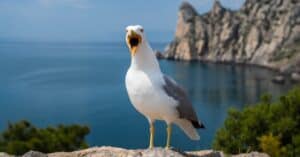Tuna is an important fish for people all over the world. Whether sought for an intense rod and reel battle by an angler or caught for sushi or canning, tuna is one of the most versatile and widely consumed foods around. Although there are many species of tuna, most people interact with the skipjack and albacore as they are the cheapest. Today, we are going to be exploring the differences between the Skipjack Tuna vs Albacore Tuna. By the end, you will know exactly what makes these fish unique!
Comparing a skipjack tuna and an albacore tuna
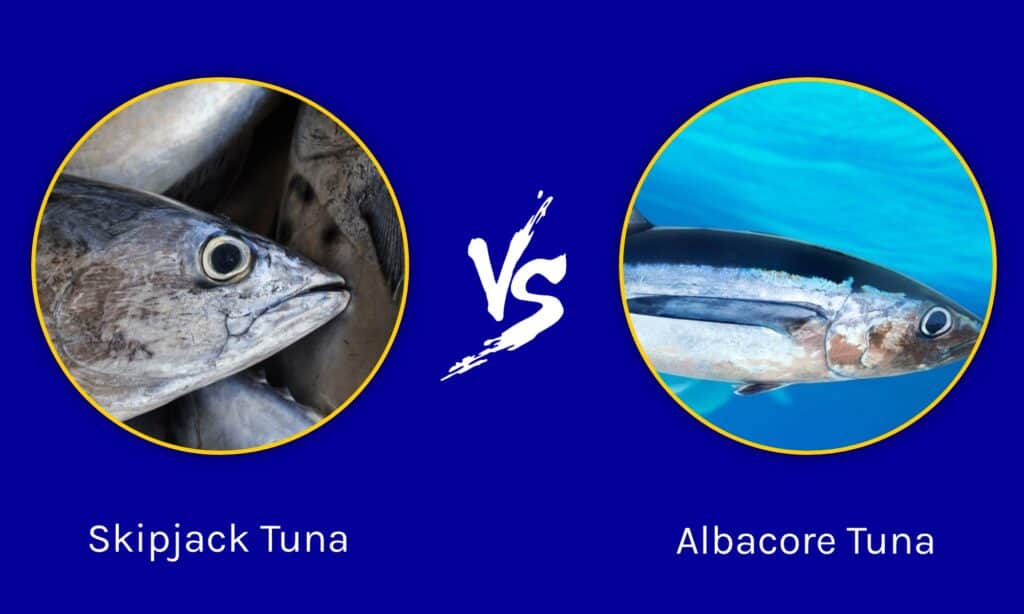
| Skipjack | Albacore | |
|---|---|---|
| Common names | Balaya, cakalang, katsuo, arctic bonito, mushmouth, oceanic bonito, striped tuna, or victor fish | White tuna, longfin tuna |
| Distribution | Tropical and warm-temperate waters worldwide | Worldwide in tropical and temperate waters, but has 6 distinct stocks in the Atlantic, Pacific, and Indian Oceans, plus the Mediterranean Sea |
| Size | Length: 2.7 feet Weight: 22 lbs | Length: 3.3 feet Weight: 75 lbs |
| Appearance | Dark-colored stripes along the lower half of the body. | Incredibly long pectoral fins with no markings. The tail tip is usually white. |
| Culinary usage | Most commonly used for canning. Used in Japanese, Indonesian, and Hawaiian cuisine. | Second most canned variety. Used for grilling and searing. |
| Yearly catch | 2.9 million tons in 2018. | 250k tons in 2018. |
The 6 main differences between a skipjack tuna and an albacore tuna
The main difference between skipjack and albacore tuna is their size, appearance, and culinary usage, especially in the United States. Skipjack are smaller, considered lower quality, and are caught in much higher numbers than albacore tuna.
Tuna is an interesting food as it can make up some of the most high-priced cuisines in the world or it can come in a can on a grocery store shelf. This variance is primarily due to the rarity and marketing of the species of tuna being caught. Most of the world’s tuna supply comes from skipjack tuna, with 70% of the US canned tuna market being entirely composed of skipjack. Albacore is generally marketed as a higher quality canned option than skipjack.
Both of these fish are top predators that live in tropical and temperate waters worldwide. Additionally, they often migrate together, with large tuna migrations consisting of multiple species of tuna. Skipjack and albacore are often seen swimming with one another, as well as larger, more prized tuna, like yellowfin and bluefin.
Despite their similarities, there are some clear differences between the two fish. Let’s take a look at the skipjack and albacore tuna to find out what makes them unique!
Skipjack Tuna vs Albacore Tuna: Common names

Skipjack tuna and albacore tuna have a variety of names in various cultures.
©funny face/Shutterstock.com
Fish go by a ton of names, especially when you move into different regions of the world. Cultures and languages all have names for things, especially when the fish is as widespread as the tuna is. The scientific name for skipjack tuna is Katsuwonus pelamis, but other names include balaya, cakalang, katsuo, arctic bonito, mushmouth, oceanic bonito, striped tuna, or victor fish.
The albacore tuna also has a few names that it goes by, albeit a few less than the skipjack. Its scientific name is Thunnus alalunga, but other names include the white tuna and the longfin tuna.
Skipjack Tuna vs Albacore Tuna: Distribution
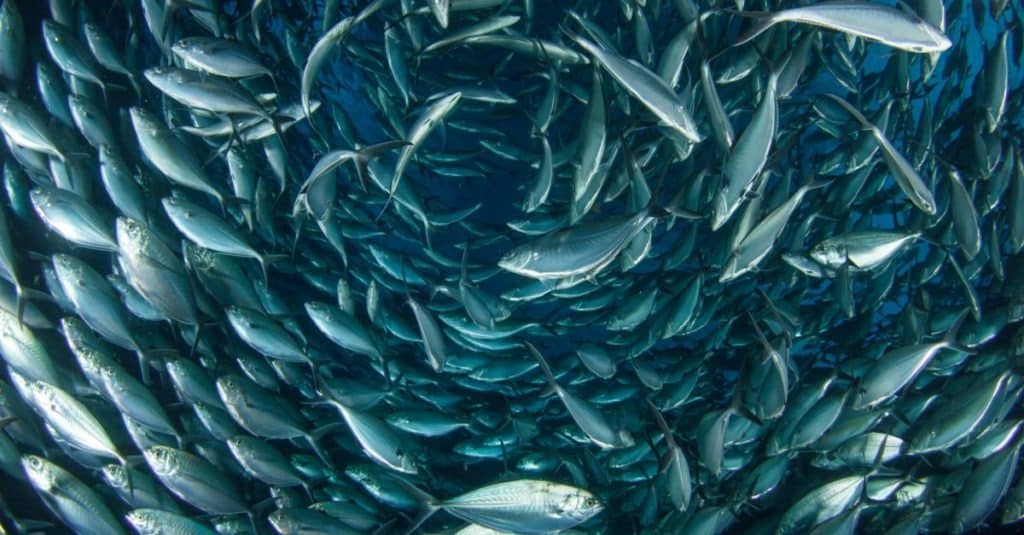
Both tuna species live worldwide, but there are six distinct stocks of albacore that are tracked.
©Rich Carey/Shutterstock.com
Both species of tuna are recognized around the world. Despite this worldwide distribution, there are a few differences in the scale that they are found in certain regions. The skipjack tuna can be found in tropical and temperate waters worldwide. They often migrate and swim in groups, usually with other tuna species, including the albacore.
The albacore tuna also has a worldwide distribution. Like the skipjack, the albacore prefers tropical and temperate waters in the uppermost region of the ocean. There are six distinct stocks that are fished across the world, however. These six stocks have a particular distribution that they stick to and can be found in the Atlantic, Pacific, and Indian Oceans, plus the Mediterranean Sea.
Skipjack Tuna vs Albacore Tuna: Size
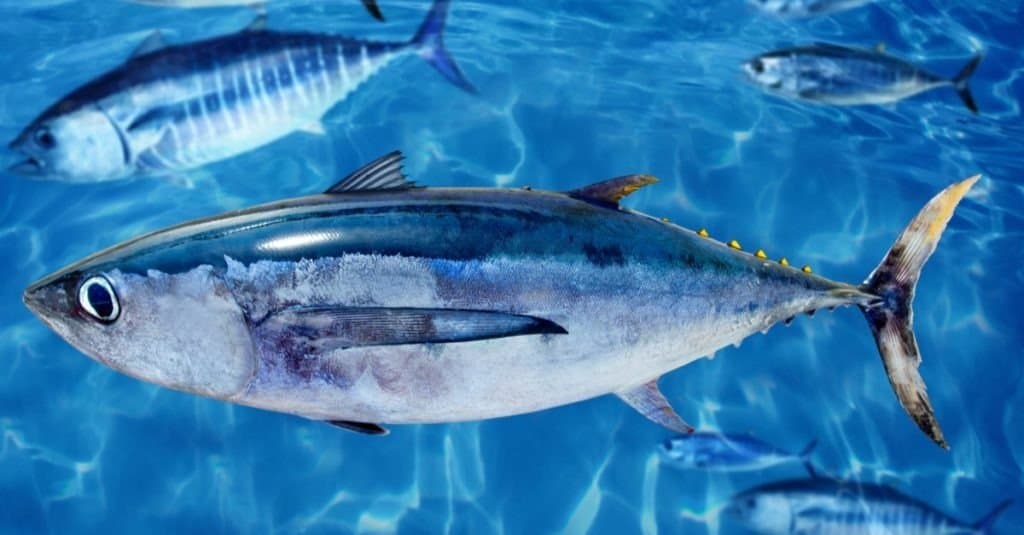
Albacore tuna are larger than skipjack tuna.
©lunamarina/Shutterstock.com
Skipjacks are among the smaller members of the tuna family. Still, these fish are quite large when compared to other fish that most people are familiar with. The skipjack usually grows to a length of 2.6 feet, but they can grow to 3.6 feet in rarer cases. Additionally, they weigh around 22 lbs but have been recorded as large as 76 lbs.
Albacore are also smaller when compared to other tuna species, but are still quite a bit larger when compared to the skipjack. Most albacore grow to a length of 3.3 feet, but some individuals have been recorded up to 4.6 feet long. Additionally, albacores usually weigh 75 lbs, with some record individuals weight up to 133 lbs.
Skipjack Tuna vs Albacore Tuna: Appearance
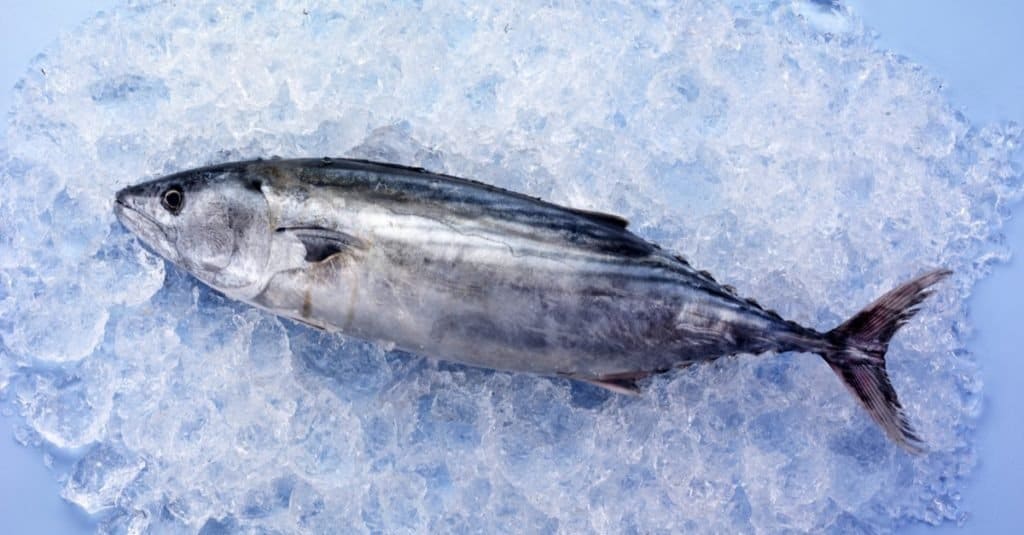
Skipjack tuna have black stripes and albacore tuna have long pectoral fins.
©CKP1001/Shutterstock.com
All tuna have similar features, but there are few easy ways to tell the difference between the skipjack and albacore. Skipjack have a dark striping pattern down both of their sides on the lower half of their bodies. Additionally, skipjack are almost always smaller than albacore.
Albacore tuna don’t have a striping pattern, or any pattern at all, across their body. The main feature distinguishing an albacore is its long pectoral fin. These fins give them the nickname “longfin tuna”, and reach between their anal fin and the fork of their tail.
Skipjack Tuna vs Albacore Tuna: Culinary usage
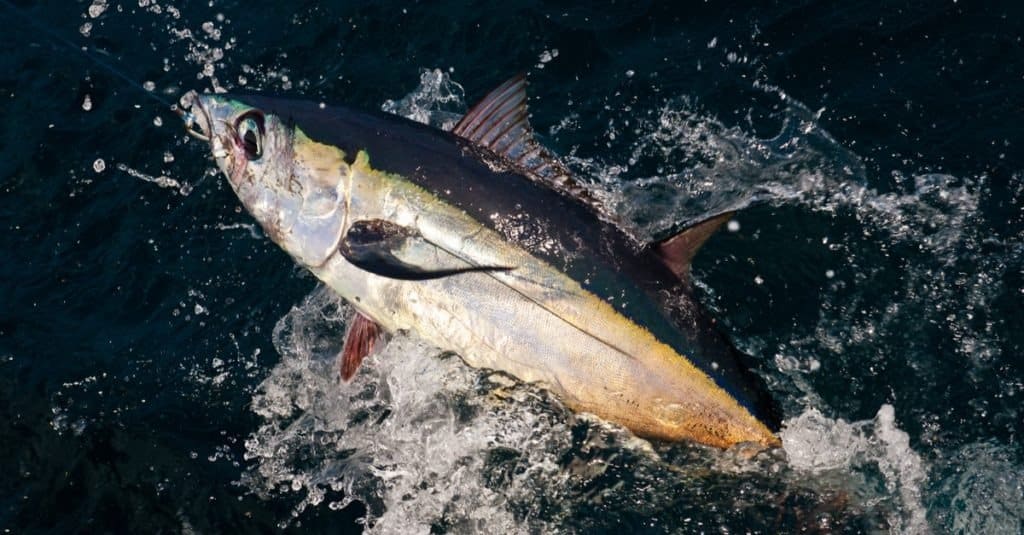
Albacore tuna is generally regarded as higher quality, but both are used worldwide in a variety of dishes.
©David Vogt/Shutterstock.com
It’s important to know that cultures around the world use both of these fish for a variety of dishes. While the United States may consider one species higher quality than the other, that isn’t always the case around the world.
Skipjack is the most caught and consumed tuna worldwide. They make up 70% of the United States tuna canning industry and are known for flesh that breaks off into large chunks (perfect for canning). It is usually regarded as the lowest quality tuna in the US. Internationally, skipjack is eaten grilled, seared, and in a variety of cultural dishes.
Albacore is the fourth most fished tuna species and makes up around 20% of US tuna canning. It is often marketed as White tuna and offered as a higher quality alternative to skipjack. It is a bit firmer of a fish and is more often used in steak form and in dishes where structure is more important. Hawaiian, Indonesian, and Japanese cuisine all use albacore as a staple meat source.
Skipjack Tuna vs Albacore Tuna: Yearly catch
Skipjack was the most caught tuna species in 2018, with a haul of 2.9 million tonnes.
Albacore was the fourth most caught tuna species in 2018, with a haul of 235k tonnes.
Are There Nutritional Differences Between Skipjack and Albacore?
Yes. The main concern is about the mercury level in tuna, which causes people to question whether to buy white or light tuna.
White tuna is albacore only. While albacore and other tunas have about the same calories and protein, since albacore is a larger fish, it has higher levels of heart-healthy Omega-3 fats. It also has Vitamins D and B-12, selenium, and iron. However, albacore has three times the mercury of skipjack, which is used in canned light tuna.
Skipjack tuna is considered the healthiest tuna by the FDA, which gave it a “Best Choice” rating, but yellowfin and albacore are listed as “Good Choice,” so they are still acceptable, and in fact, are nutritious. As long as you don’t eat massive amounts of albacore (white tuna), you shouldn’t have anything to worry about. (By the way, bigeye tuna has the highest mercury level.)
The photo featured at the top of this post is © lunamarina/Shutterstock.com
Thank you for reading! Have some feedback for us? Contact the AZ Animals editorial team.






